
Survey: Retailers Raise Concerns About Continued Return Fraud
A recent survey by the National Retail Federation found fraudulent returns expected to add up to a nearly $9 billion problem the industry again last year—with pressure ratcheting up during the holiday season.
A recent survey by the National Retail Federation found fraudulent returns are expected to add up to a nearly $9 billion problem for the industry last year—with pressure ratcheting up during the holiday season.
With the holidays over, it’s likely that a few gifts might get sent back to the store. (Nothing personal; it just didn’t fit, Grandpa.)
While these kinds of returns are par for the course for many retail outlets, the National Retail Federation (NRF) is sounding the alarm about the dangers of return fraud. The association’s recent Return Fraud Survey projected that the practice cost the retail industry almost $3.4 billion during the 2013 holiday season. More details:
A widespread problem: Like credit-card fraud, which has drawn much attention in the wake of the Target incident last month, return fraud is something nearly all retailers have dealt with in some form, according to the NRF survey. The most common form, according to the retail loss-prevention executives polled, is the return of stolen merchandise: 94.8 percent of respondents say that their company dealt with such cases in 2013. Other common forms include return fraud involving employees (93.1 percent); returns of items purchased with fraudulent funding sources (69 percent); “wardrobing,” the return of already-used merchandise or clothing (62.1 percent); and retail fraud by organized crime groups (60.3 percent). While overall fraudulent returns were projected to see a relatively modest $50 million decline from 2012 figures, the amount for the holiday season alone was expected to increase by about that much.
A bigger deal than it seems: According to the association, return fraud—which the survey estimates cost retailers $8.76 billion in 2013—doesn’t draw the headlines that more high-profile incidents do, but it has a major effect on the bottom line nonetheless. “While coverage of this issue paints return fraud as one of the ‘less severe’ retail crimes, the fact of the matter is that returning used or stolen items, or even using false tender to purchase items, is fraud, period,” NRF Vice President of Loss Prevention Rich Mellor said in a statement. “Recent efforts to combat fraudulent activity are slowly starting to work, but criminals are becoming more savvy and technologically advanced in their methods, making it even more difficult for retailers and law enforcement to keep up with the growing problem.”
One way retailers are working to help stem the tide of return fraud is by requiring people who bring back merchandise to show identification along with their receipts—a practice the survey found had increased by 5 percent since 2012.
(David Goldman/Getty Images News)






Comments